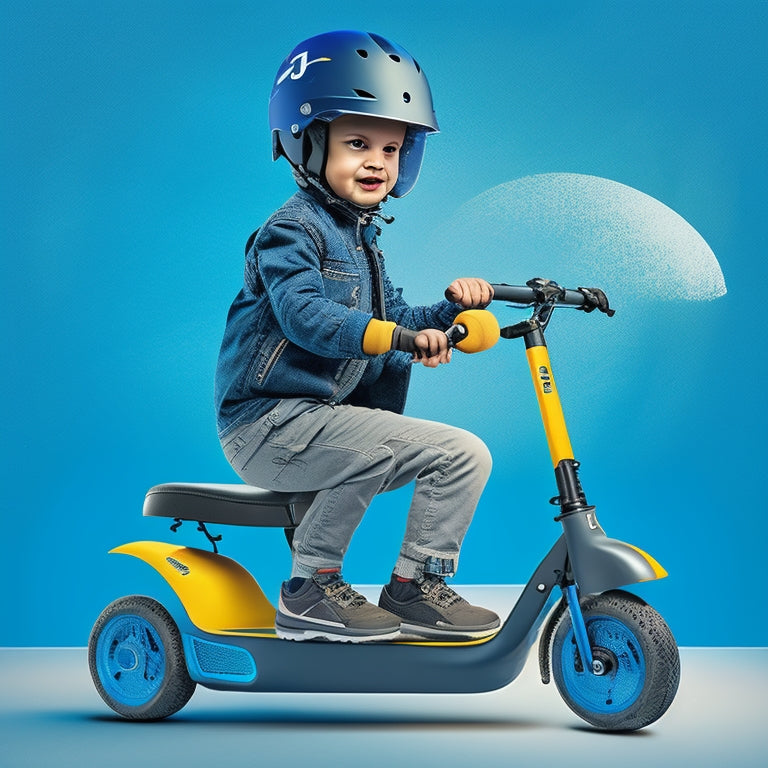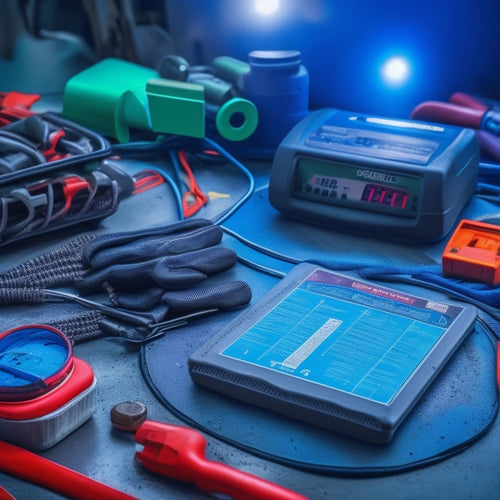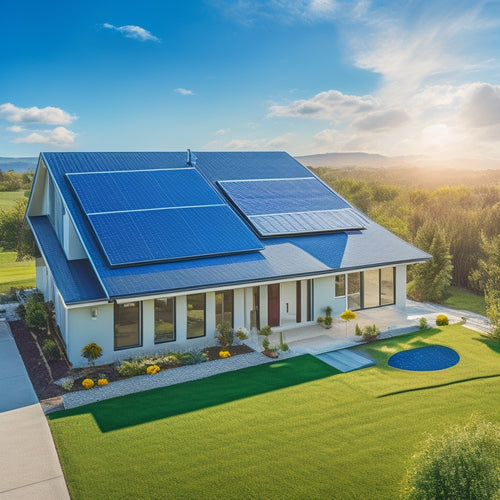
What Safety Features Should Kids' Electric Scooters Have?
Share
When shopping for a kids' electric scooter, you'll want to prioritize models with essential safety features. A dependable braking system with regenerative braking and wheel alignment for stability is vital. Thermal monitoring, cell balancing, and overcharge protection guarantee battery safety. Speed limiters and governors provide controlled riding experiences. Look for scooters with safety certifications like UL and CE marks. Don't forget protective gear like helmets, knee pads, and elbow guards. Visibility features like integrated lights and reflective elements are also critical. By considering these features, you'll find a scooter that provides a safe and enjoyable ride - and there's even more to explore when it comes to ensuring your child's safety.
Key Takeaways
• A reliable braking system with regenerative braking and wheel alignment for stability is essential for kids' electric scooters.
• Battery safety features, including thermal monitoring, cell balancing, and overcharge protection, are crucial to prevent overheating and fires.
• Speed limiters and governors are necessary to regulate speed and acceleration, providing a safe and controlled riding experience.
• Safety certifications, such as UL and CE marking, ensure compliance with safety standards and regulations, providing assurance for parents.
• Protective gear, including helmets, knee pads, and elbow guards, should be worn to reduce injury risk and provide peace of mind.
Braking System and Stability
When riding a kids' electric scooter, a dependable braking system and stable design are essential to prevent accidents, as you'll be relying on these features to come to a safe stop or navigate rough terrain.
A reliable braking system should include regenerative braking, which captures some of the kinetic energy and converts it back into electrical energy, recharging the battery. This not only helps you stop safely but also increases the scooter's overall efficiency.
In addition to a reliable braking system, a stable design is vital to prevent accidents. The scooter's wheel alignment plays a significant role in maintaining stability. Proper wheel alignment ensures that the scooter tracks straight and doesn't wobble or vibrate excessively, reducing the risk of losing control or crashing.
A well-designed scooter will also have a low center of gravity, making it more difficult to tip over. By combining a dependable braking system with a stable design, you can ride with confidence, knowing that your scooter is designed with safety in mind.
Battery Safety and Protection
Your kids' electric scooter's battery safety and protection features are critical, as they directly impact the overall safety and reliability of the ride. A well-designed battery system should have multiple layers of protection to prevent overheating, overcharging, and electrical shorts. Look for scooters with thermal monitoring, which detects and responds to abnormal temperature fluctuations. This feature helps prevent battery damage and reduces the risk of a thermal runaway.
| Feature | Description | Importance |
|---|---|---|
| Thermal Monitoring | Monitors battery temperature in real-time | Prevents overheating and thermal runaway |
| Cell Balancing | Ensures individual cells are charged and discharged evenly | Prevents cell damage and prolongs battery life |
| Overcharge Protection | Cuts off power supply when battery is fully charged | Prevents overcharging and reduces wear |
| Short-Circuit Protection | Detects and interrupts electrical shorts | Prevents electrical fires and damage |
When choosing an electric scooter for your kids, make sure to prioritize battery safety and protection features. A reliable and safe battery system guarantees a fun and worry-free riding experience for your child.
Speed Limiters and Governor
Most kids' electric scooters come equipped with speed limiters and governors that restrict the scooter's maximum speed to guarantee a safe and controlled riding experience. These features are designed to prevent accidents caused by excessive speed. As a parent, you want to make sure your child is riding at a safe pace, and speed limiters and governors provide that assurance.
Here are some key aspects of speed limiters and governors:
-
Power Capping: This feature limits the scooter's power output, preventing it from exceeding a certain speed. This ensures your child can't accidentally accelerate too quickly.
-
Speed Regulation: This feature allows you to set a maximum speed for the scooter, giving you control over how fast your child can ride.
-
Customizable Speed Limits: Some scooters allow you to adjust the speed limiter to suit your child's skill level and riding environment, giving you greater flexibility and peace of mind.
Safety Certifications and Compliance
When you're shopping for a kids' electric scooter, you'll want to look for safety certifications and compliance marks that guarantee the product meets rigorous safety standards.
You should check for certifications like UL (Underwriters Laboratories) and the European Safety Mark, which confirm that the scooter has passed rigorous testing and inspection.
UL Certification Standards
The UL certification mark on a kid's electric scooter indicates that it has met rigorous safety standards set by Underwriters Laboratories, a non-profit organization that has been testing and verifying product safety for over a century. As a parent, you want to make sure that your child's scooter has undergone thorough UL testing to guarantee its safety.
The certification process involves a series of tests that evaluate the scooter's electrical, mechanical, and environmental performance.
-
Electrical safety testing: Verifies that the scooter's electrical components meet safety standards for voltage, current, and temperature.
-
Mechanical testing: Assesses the scooter's structural integrity, including its ability to withstand impact and stress.
-
Environmental testing: Evaluates the scooter's performance in various environmental conditions, such as temperature and humidity extremes.
European Safety Mark
As you consider other safety certifications for your child's electric scooter, you'll want to look for the European Safety Mark, a certification that guarantees compliance with EU safety standards. The CE marking, also known as the Conformité Européene marking, is a mandatory requirement for products sold in the European Union. It validates that the scooter meets the essential health and safety requirements outlined in the EU's New Approach Directives.
When you see the CE marking on your child's scooter, you can be confident that it has been designed and manufactured with safety in mind. The CE marking is based on the EN certification standards, which provide a set of guidelines for manufacturers to follow. These standards cover aspects such as safety, performance, and environmental impact. To obtain the CE marking, manufacturers must ensure that their products comply with these standards.
Compliance With Regulations
You'll need to verify that your child's electric scooter complies with regulations, which involves checking for specific safety certifications and ensuring the manufacturer has adhered to strict guidelines. This is important in guaranteeing your child's safety while riding.
When researching, look for certifications like the UL (Underwriters Laboratories) mark, which indicates compliance with safety standards in the United States. Additionally, check for age restrictions, as some scooters are designed for kids above a certain age.
Some key aspects to keep in mind when verifying compliance include:
-
Manufacturer transparency: Look for clear information on safety features, materials used, and testing procedures.
-
Adherence to local regulations: Ensure the scooter complies with local laws and regulations regarding speed, usage, and safety gear.
-
Regular updates and testing: Check if the manufacturer regularly updates and tests their scooters to guarantee ongoing compliance with safety standards.
Protective Gear and Accessories
Wearing a properly fitted helmet is crucial, as it reduces the risk of head injuries by up to 70%. You should make sure the helmet fits snugly and isn't loose, with the straps adjusted to fit your child's head.
Additionally, consider investing in knee pads and elbow guards to provide extra protection for your child's joints. These protective gear accessories can greatly lessen the risk of scrapes, bruises, and broken bones in the event of a fall. Look for knee pads and elbow guards specifically designed for scooter riding, as they provide targeted protection for high-impact areas.
When choosing protective gear, make sure it's certified to meet safety standards, such as those set by the Consumer Product Safety Commission (CPSC) or the Snell Memorial Foundation. By equipping your child with the right protective gear, you can notably reduce the risk of injury and provide peace of mind while they ride.
Visibility and Illumination Features
Your child's visibility on the scooter is important, particularly in low-light conditions, so look for models featuring integrated lights, reflectors, or bright colors to increase their visibility to pedestrians, cyclists, and motorists. This is vital for nighttime visibility, as it reduces the risk of accidents and guarantees your child can be seen from a distance.
When shopping for a kids' electric scooter, consider the following visibility and illumination features:
-
Reflective Decals: Look for scooters with reflective decals or stickers that can be applied to the scooter's frame, increasing visibility in low-light conditions.
-
Integrated Lights: Opt for scooters with built-in front, rear, or side lights that provide visibility to others and help your child see the road ahead.
-
Bright Colors: Consider scooters with bright, neon colors that can increase visibility, especially in low-light conditions.
Frequently Asked Questions
Can Kids Ride Electric Scooters in the Rain or Wet Conditions?
When you let your kid ride an electric scooter, check the manufacturer's guidelines for Rain Safety and Wet Performance; if it's not designed for wet conditions, it's best to avoid riding in the rain to prevent accidents.
Are Electric Scooters Suitable for Kids With Physical Disabilities?
You'll be relieved to know that many electric scooters now offer accessible designs with adaptive features, enabling inclusive riding experiences for kids with physical disabilities, allowing them to ride safely and confidently.
Can I Customize or Modify My Kid's Electric Scooter?
'Measure twice, cut once' - wise words when customizing your kid's electric scooter. You can upgrade with scooter accessories, exploring personalization options like colorful decals, ergonomic grips, or adjustable handlebars to guarantee a perfect fit for your child's unique needs.
How Do I Store My Kid's Electric Scooter When Not in Use?
When you're not using your kid's electric scooter, you'll want to store it safely; consider investing in scooter racks or installing garage hooks to keep it off the floor, organized, and protected from damage.
Can I Use My Kid's Electric Scooter on Steep Hills or Slopes?
When you ride your kid's electric scooter, consider Hill Safety: check the slope ratings to make sure the scooter's capabilities match the terrain, and adjust your speed and braking accordingly to avoid accidents on steep hills or slopes.
Related Posts
-

5 Essential Car Battery Maintenance Tips
You can extend your car battery's lifespan and prevent unexpected breakdowns by following five essential maintenance ...
-

5 Best Steps to Installing Solar Panels at Home
You're about to start on a journey to harness the power of solar energy at home. First, assess your home's solar pote...
-

Why Go Solo in Urban Transportation?
You're taking control of your daily commute by ditching the crowds and going solo, and that's a smart move. By choosi...


